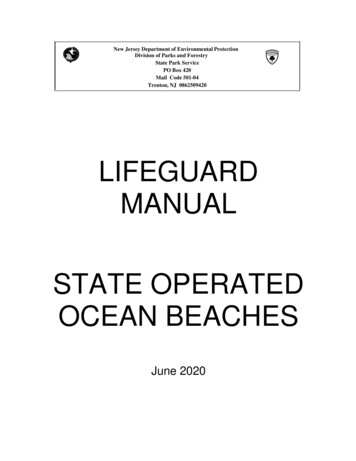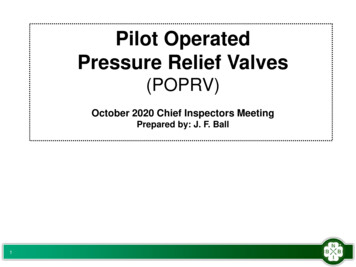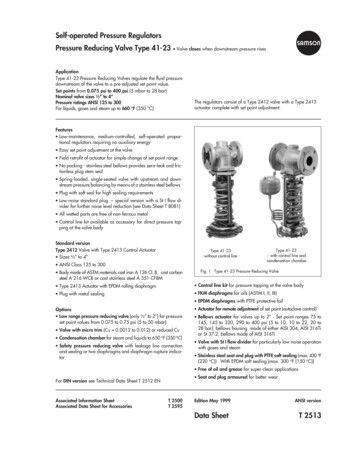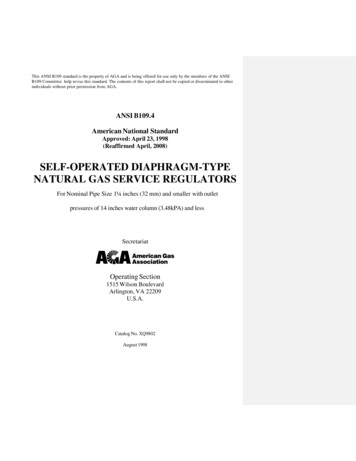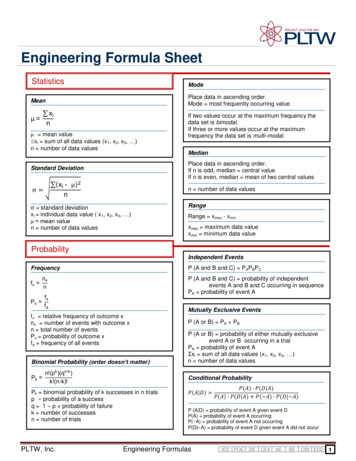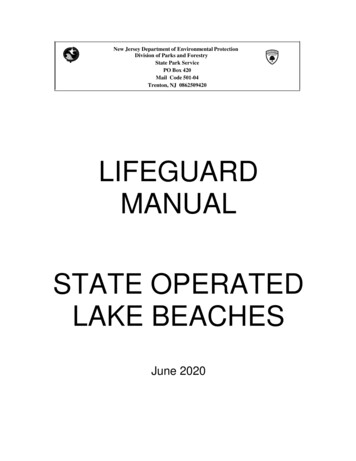
Transcription
New Jersey Department of Environmental ProtectionDivision of Parks and ForestryState Park ServicePO Box 420Mail Code 501-04Trenton, NJ 0862509420LIFEGUARDMANUALSTATE OPERATEDLAKE BEACHESJune 2020
TABLE OF CONTENTSForeword . 3Required Reading for all NJ State Lifeguards . 4PERSONNELI.II.III.IV.V.VI.Responsibility .6Training.8Public Relations . 11Personal Injury on Duty.12Pathogen Exposure .13Information and Guidelines on Sun Protection .16REGULATIONSI.II.III.IV.V.VI.Personnel Regulations .22Uniform Regulations .24Flotation Devices .25Beach/Bathing Regulations .26Enforcement of Beach & Bathing Regulations .27Disciplinary Policy .27EQUIPMENT AND REGULATIONS AND USESI.II.III.IV.V.VI.VII.VIII.IX.X.XI.General Equipment Regulations .29Lifeguard Stands. .29Flags .30Kayaks .31Torpedo Buoys.40Backboard and Cervical Collars .42Pocket Masks and Bag Valve Masks .57Beach Wheelchair .58Mask, Fins, Snorkel .58Emergency Oxygen .60Automated External Defibrillator .601
II.Opening and Closing .62Communications .62Summoning Aid .65Lost Children (Persons) .65Missing Children (Persons) .66Water Search .66Sighted Submersion .67Disturbances .72Lightning .72Guarding .72Rescue Procedure and Coverage .77Removing Victims from Shallow Water to Beach.78Rescue Without Lifesaving Equipment . 802
FOREWORDLifeguards are responsible for the safety and wellbeing of the patrons who swim at their beach. To meetthis responsibility a lifeguard needs:l.Knowledge of rescue procedures coupled with swimming ability;2.A thorough familiarity with lifeguard equipment and the techniques used in its application;3.The confidence to analyze and act effectively to situations in the water and on the beach;4.Trained eyes, so that visual control can be maintained over the area of responsibility;5.To be physically fit, to meet the physical demands of the job.A lifeguard also has the responsibility to help ensure that each patron has the optimum opportunity toenjoy the public facilities.The information contained within this manual is the result of years of experience, research, and practicalapplication. It is based on common sense, and the basic components of open‑water lifeguarding. The rulespertaining to the public are based on providing recreation, health and safety for the majority. The personnelrules are not unreasonable and are for the protection of the public and lifeguards, while maintaining thatdegree of discipline necessary for the effective execution of a lifeguard’s duties.3
REQUIRED READING FOR ALL LIFEGUARDS1.Seasonal Employee Manual (State Park Service)2.Lifeguard Manual (State Park Service)3.First Aid/CPR/AED Participant’s Manual (American Red Cross) Revised 2016 ISBN978-1-58480-479-6 or American Safety and Health Institute Advanced First AidManual4.CPR/AED for the Professional Rescuer and Healthcare Provider(American Red Cross) Revised 2016 ISBN 978-0-9983745-3-6, , orAmerican Health and Safety Institute BLS materials5.Lifeguarding Textbook (American Red Cross)ISBN 0‑86536‑181‑96.Open Water Lifesaving USLA Manual 2nd EditionISBN 0‑536 73735‑5American Red Cross Textbooks are available from the following m4
PERSONNEL5
I.RESPONSIBILITYA.Area Superintendent ‑ The area Superintendent is responsible for all activities within thearea and is the highest authority.B.Water Safety Supervisor - There is a Water Safety Supervisor in each region. This personassists the area Superintendents to ensure that all bathing areas are safely maintained andmanaged. As a member of the regional staff, this position is directly responsible to theRegional Superintendent.C.Head Lifeguard ‑ The head lifeguard (Lt. or Sgt.) is responsible for maintaining a safewaterfront and transmitting orders, policies and procedures from the area Superintendentto the lifeguard staff. As administrative head of the lifeguard staff, the head lifeguard isresponsible for:D.E.1.Organizing, training, scheduling and supervising the lifeguards.2.Performing all lifeguard duties.3.Enforcing all regulations.4.Evaluating each lifeguard.5.Beach management.6.Maintaining required records.7.Daily inspection of beach area, First Aid Room and all facilities assigned to the lifeguards.8.Daily inspection of equipment and supplies.9.Reporting needed repairs or new/replacement equipment.10.The morale of the lifeguards.11.Reporting all safety and serious disciplinary problems to the area SuperintendentNext‑in‑Command - In the absence of the head guard, the next‑in‑command performsthose duties as outlined in C above. Normally the duties are:1.Carries out orders issued by the head lifeguard.2.Responsible for the efficient performance and training of the lifeguards he or sheis assigned to supervise.3.Perform all lifeguard duties.Lifeguard Duties1.Pass all sections of lifeguard employment test prior to being hired.6
F.2.Stay alert and scan patrons in the bathing area.3.Safeguard and regulate the conduct of patrons in the bathing area to preventconditions that may lead to an accident.4.Enforce beach and bathing area regulations.5.Performs rescues, CPR and rescue breathing when necessary.6.Performs first aid at a level consistent with American Red Cross First Aid exceptin the case of a broken bone or dislocation. In the case of a broken bone ordislocation, the lifeguard will keep the victim stationary and comfortable until theambulance arrives. The ambulance crew will splint and move the victim. ONLYif the situation requires the lifeguard to move the victim immediately, thefractures must be immobilized by splinting first.7.Maintain and efficiently utilize lifeguard equipment.8.Assist in maintaining a clean beach, employees’ area and First Aid Room.9.Assist in maintaining records.10.Meet all training requirements.11.Perform other duties as required or assigned.Lifeguard First Aid Duties1.Maintain first aid supplies in proper quantities and complete inventory every twoweeks.2.Check and refill first aid kits at the start of each day.3.Maintain strict cleanliness in the first aid area.4.Maintain first aid equipment in a clean, neat and workable condition.5.Keep the head lifeguard informed of the status of first aid supplies and equipment.6.Fill out and file a first aid report on first aid administered.7. Review Red Cross First Aid and CPR/AED and/or ASHI BLS and Advanced FirstAid periodically throughout the season.books periodically throughout the season.8.G.Must wear gloves when performing first aid or CPR. If the situation dictates,more protection (gowns and face shields) must be worn.Unacceptable Lifeguard Conduct ‑ Any let down in performance of duties that creates anunsafe situation, will not be tolerated and may lead to dismissal.7
II.TRAININGA.B.First Aid/CPR ‑ All lifeguards must have current American Red Cross ProfessionalCPR/AED, Bloodborne Pathogen Training, Oxygen Administration, First Aid certificatesand/or American Safety and Health Institute BLS, Advanced First Aid and BloodbournePathogens, certificates and be competent in the use of backboards and cervical collars.These skills will be reviewed throughout the season during in‑service training.Physical ‑ A lifeguard must meet physical training requirements each week.1.The head lifeguard will be responsible in seeing that the physical training requirementsand records are carried out. The head lifeguard may designate a physical training officerto administer physical training; however, the head lifeguard is ultimately responsible.2.Each full‑time lifeguard must complete ten physical training requirements eachweek. Training requirements should be spread out over multiple daysthroughout the week. A Lifeguard officer, Superintendent or Water SafetySupervisor may assign physical training requirements as a part of the dailyrotation.Substitution of one requirement for another is only permitted with prior permissionof Water Safety Supervisor. On occasion, a guard may be exempted from physicaltraining requirements. EXAMPLE: Lifeguard did not work all 5 days or bathing areais closed.3.Lifeguards working less than a 5-day week must complete a minimum of 2training requirements per day.4.On occasion, a guard may have to do more than the minimum requirements in a week.5.Physical training may only be done during working hours when it does not compromisethe safety of the bathers.6.Failure to complete required training will result in disciplinary action or dismissal.7.Supervisory lifeguards may allow guards to perform exercises individually or conductstructured sessions that include all guards. Sessions involving all guards must be priorto 10 a.m.8.Description of Required Physical Training. To meet the 10 requirements a paddleor a swim must be done in addition to the following:SWIMMinimum requirement is four 500-meter swims in at least 500-meterincrements. When a lifeguard swims long distances from the bathing area orwhere boats maybe present, extra safety precautions should be taken.8
PADDLEMinimum requirement is three 1,000-meter kayak paddles in at least 1,000-meterincrements.RUNMinimum requirement is three miles a week in at least one‑mile increments.C.Rescue Procedures and Techniques - All rescue techniques and emergency procedureswill be learned. As much time as necessary will be spent in acquiring and maintainingproficiency in these skills.D.Lifeguards are responsible for knowing all procedures, skills and regulations in thelifeguard manual and passing an examination on that material. Any lifeguard cheating onthe manual test will be dismissed.E.Lifeguards are responsible for all material in the Seasonal Employee Manual.F.The following outlines the training to be received by new guards. This material must bereviewed by all returning lifeguards prior to carrying out lifeguard functions. Allguards will review these skills and procedures throughout the season.ALL LIFEGUARDS ARE SUBJECT TO TESTING IN THE ABOVE SKILLS, AND THEIR PHYSICALCONDITION, AT ANY TIME.9
TRAINING PROGRAMA.Orientation1.Objectives and Goals of Training Program2.Using the lifeguard manual to achieve the objectives and goals of the training program3.Chain‑of‑Command and Scope of Authority4.Introduction to Equipment and Facilitiesa.b.c.d.e.f.5.Introduction to “Job of a Lifeguard”a.b.c.d.e.f.g.h.6.B.Skills and performance requiredResponsibilityPhysical Fitness and In‑Service TrainingPreventative LifeguardingPublic RelationsEnforcement of Beach & Bathing Area RegulationsPersonnel RegulationsDisciplinary PoliciesCommunicationsa.b.c.d.7.Torpedo Buoys (Rescue Cans, Torps)KayaksFirst Aid and CPR/AED EquipmentBackboards and Related EquipmentLocation of all Supplies and EquipmentSigns (Text, Location, Etc.)Hand and Whistle SignalsTelephone ProceduresRadio ProceduresMegaphone and Public AddressEnvironmental HazardsLifeguarding Skills and Procedures1.Scanning2.Rescue and Emergency Coverage, Procedures3.Rescues with Equipment10
a.b.c.d.e.4.Torpedo buoyKayakConscious VictimsUnconscious Victims discuss in water rescue breathing with protection. (Ref. OpenWater Lifesaving USLA Second Edition pg. 264.)Multiple VictimsRescues without Equipmenta.b.c.d.e.ApproachesLevel OffsCarriesDefensesReleases and Escapes5.Mask, Fins, Snorkel6.Water Search7.Submersion8.Lost and Missing Persons9.Emergency Care and Transportation of Ill and Injureda.b.c.d.American Red Cross CPR/AED (Bloodborne Pathogen training, oxygenadministration and airway management will be covered in CPR class) and/orASHI BLS.American Red Cross First Aid Including: Assisting with Asthma Inhaler andEpinephrine Injector and/or ASHI Advanced First AidNeck and back injuries in the waterReview pages 207 to 210 Open Water Lifeguarding USLA Manual 2nd Editionin the unlikely event of having to interact with a helicopter. Pay attention tostatic electricity when lowering a landing cable.C: Examinations:III.l.Written Examinations on all phases2.Practical Examinations on all phases3.Timed SwimsPUBLIC RELATIONSLifeguards must remember that they work for a public service agency. Lifeguards are to be courteousat all times. Personal contact with a patron is preferable to yelling, whistle or megaphone, when poss‑ible. Lifeguards will enforce the rules for the area. Any difference of opinion will be referred to thehead lifeguard, other supervisor, area office or State Park Police. Use of any offensive or obscenelanguage by a lifeguard will not be tolerated. A lifeguard’s conduct is a reflection uponthe State of New Jersey. Lifeguards are expected to conduct themselves during duty hours and offduty hours, in such a manner as to bring credit upon themselves, co‑workers and the area in which11
IV.they work.PERSONAL INJURY WHILE ON DUTYWhenever the service of a doctor, dentist or hospital is needed because of an injury sustained whileworking, the area office must be notified prior to obtaining services when possible. The office willdirect you to the nearest approved medical facility. If the facility is closed and urgent care is needed,proceed to the nearest hospital. Bills for doctors, the hospital, medication, etc. will be paid by theState of New Jersey in these cases. Check with the area office before paying with your own moneyor going to a doctor of your choice.An employee first aid report must be filled out and signed by the immediate supervisor forany injury sustained on the job12
V. BLOODBORNE PATHOGEN EXPOSUREPathogens are disease-causing agents such as bacteria, viruses and other agents thatpresent themselves in blood and other potentially infectious materials (OPIM). Virusesinclude: Human Immunodeficiency (HIV), Hepatitis B, Hepatitis C, and others. OPIMare defined as semen, vaginal secretion, cerebrospinal fluid, synovial fluid, plural fluids,pericardial fluid, peritoneal fluid, amniotic fluid, unfixed tissues or organs, and any bodyfluids visibly contaminated with blood.When a lifeguard is performing first aid, CPR or other duties, he or she may be exposedto Bloodborne Pathogen or OPIM.A. Pathogen exposure is defined as any contact with blood or OPIM of anotherperson that may enter the body through a needle stick, open cut, sore, or mucousmembranes such as eyes or oral cavities. Contact with saliva, urine, feces, vomit,or sputum visibly contaminated with blood is considered an exposure.1. If exposure occurs:a. Immediately wash effected area with soap and water. Antiseptic may beapplied if available. The sooner the contamination is washed off, the lesschance of infection. If splashed around mouth or nose, flush area withclean water. If eyes are affected flush for 20 minutes.b. Immediately notify the area superintendent who must direct you to thenearest hospital or medical facility for treatment. The superintendent will fillout a RM-2 and contact appropriate state offices.c. Go to approved medical facility immediately, explain exposure, and that thisis a Workman’s Compensation related injury. If approved facility is closedor approved facility information is not available go to the nearest hospital.Do not delay.2. When medical care has been completed for pathogen exposure the effectedlifeguard must submit the following documentation from the medical providerto:Office of Occupational Health and Safety (OOHS)PO Box 416Trenton, NJ 08625Fax: 609-984-2488a. That he/she has been informed of any medical testing resultsb. That he/she has been educated about medical conditions that can resultfrom exposure to blood or OPIM.B. To prevent pathogen exposure a lifeguard:13
1. Will be trained in Red Cross and/or ASHI Bloodborne Pathogen andDisease Prevention along with OOHS Bloodborne Exposure Control Planfor State Lifeguards and OSHA Bloodborne Pathogen Regulation 29 CFR1910.1030. This training will be done yearly.a. OSHA Bloodborne Pathogen standards are available online b. OOHS Complete Bloodborne Pathogen Exposure Control Plan forState Lifeguards is available at training and park office.2. Must always use universal precautions whenever contact with body fluidsis anticipated. Universal Precautions requires the employer and employeeto assume that all human blood and body fluids are infectious for HIV,Hepatitis, or other Bloodborne Pathogen.3. Must always use Personal Protective Equipment (PPE) including latexfree disposable gloves and resuscitation protective device whenperforming first aid, CPR, or whenever contact with body fluids orblood is anticipated. Gowns, and eye protection are also available.4. Dispose of PPE after each use and each victim. The same PPE should notbe used on multiple victims.5. Hands should be washed if possible before providing care. Hands must bewashed immediately following removal of gloves. If soap and water is notavailable other washing methods such as alcohol-based sanitizers must beused. Sanitizers are only a temporary solution. Soap and water should beused as soon as possible. There shall be no eating, drinking, smoking,handling contact lenses, or applying cosmetics until hands are washedwith soap and water.C. Contaminated (Infected) materials, clothing, or regulated waste must be handled asfollowed:1. Uniforms with any blood or body fluids from another person on them mustbe discarded. Do not attempt to wash or clean.2. Non-disposable contaminated materials (backboard, floor, etc.) must becleaned, and then sanitized with diluted bleach (12 ounces bleach to 1gallon of water, about 10%). The bleach solution should stand for at least10 minutes then be wiped dry.3. To dispose of any materials completely saturated with blood or bodyfluids (Saturated means if the material was squeezed fluid would escape),follow the procedures below:14
a. Give saturated material to ambulance. They have a bag for thismaterial. The ambulance disposes of material at the hospital.b. If an ambulance does not respond to first aid and blood saturatedmaterials must be disposed of. The State Park Police must becontacted for disposal (Ambulance is first option).c. Unsaturated materials (like some blood on gauze, band-aid, etc.) isthrown in regular trash.4. Do not touch syringes or any medical waste found on beach or bathingcomplex. State Park Police must be notified for disposal. Keep publicaway from material. Park Police must notify NJ DEP CommunicationCenter of incident.D. Hepatitis B Immunization – All Lifeguards will be offered a free Hepatitis BVaccination when hired. This immunization is not mandatory.1. All lifeguards must complete the Hepatitis Immunization Form, every yearto indicate acceptance, refusal, or already received immunization.2. Lifeguards who have already received immunization and want to be testedfor effectiveness of previous immunization may request a titer on theHepatitis immunization form.3. The vaccine is prepared from recombinant yeast cultures rather thanhuman blood and as a result there is no risk of contracting the Hepatitis BVirus from the vaccine.4. The park superintendent will notify you of the date and time you are toreceive injection 1 and 2 of the immunization series. This is considered awork assignment and you will be provided transportation.5. Injection 3 is 5 months after injection 2. The 3rd injection is scheduled inDecember or January. At this time the lifeguard is no longer an employee ofthe state of New Jersey. As a courtesy the third injection is free of charge.However, the lifeguard is responsible to call OOHS at 609-292-1408 toschedule injection 3. The lifeguard is responsible to supply their owntransportation for injection 3. Lifeguards may elect to have their ownphysician administer the 3rd injection. If that is the case, documentation isrequired and must be sent to: OOHS, PO Box 416, Trenton, NJ 08625-0416If a lifeguard declines immunization when hired, he or she mayrequest vaccination at a later date.15
VI.INFORMATION AND GUIDELINES ON SUN PROTECTION ‑ EACH LIFEGUARD WILLBE ISSUED SUNSCREEN AND POLARIZED SUNGLASSES WITH UV PROTECTIONA.The following information is reprinted from the pamphlet “The Sun and Your Skin” withthe permission of the American Academy of Dermatology, P.O. Box 4014, Schaumburg,Illinois 60168‑4014.“The Sun and Your Skin”Soaking up the sun’s rays used to be considered healthy, before we learned about thedangers of ultraviolet rays.Sunlight can be used to treat some skin diseases, but we all need to avoid overexposure tothe sun. Too much sun can cause wrinkles, freckles, skin texture changes, dilated bloodvessels and skin cancers. It may also cause other problems.The Sun’s RaysThe sun produces both visible and invisible rays. The invisible rays, known as ultraviolet‑A(UVA) and ultraviolet‑B (UVB), cause most of the problems. Both cause suntan, sunburnand sun damage. There is no “safe” UV light.Harmful UV rays are more intense in the summer, at higher altitudes and closer to the equator.For example, Florida receives 150% more UV than Maine. The sun’s harmful effects arealso increased by wind, reflections from water, sand and snow. Even on cloudy days UVradiation reaches the earth.Protection from the SunUsing sun protection will help prevent skin damage and reduce the risk of cancer. The AmericanAcademy of Dermatology recommends that you avoid deliberate sunbathing, wear a wide‑brimmed hat, sunglasses and protective clothing and if you must be in the sun, use asunscreen with a sun protection factor (SPF) of at least 15, even on cloudy days.Sunscreens work by absorbing, reflecting or scattering the sun’s rays on the skin. They areavailable in many forms, including ointments, creams, gels, lotions and wax sticks. All arelabeled with SPF numbers. The higher the SPF, the greater the protection from sunburn,caused mostly by UVB rays. Some sunscreens, called “broad spectrum,” block out bothUVA and UVB rays. These do a better job of protecting skin from other effects of the sun,including rashes. Sunscreens are not perfect, however. Sun protection should always startwith avoiding peak sun hours and dressing sensibly.Sunscreens should be applied about 20 minutes before going outdoors. Even water‑resistantsunscreens should be reapplied often, about every two hours or after swimming or strenuousactivities.Beach umbrellas and other kinds of shade are a good idea, but they do not provide full protectionbecause UV rays can still bounce off sand, water and porch decks. Remember, UV rays areinvisible.16
Most clothing absorbs or reflects UV rays, but white fabric like loose-knit cotton and wetclothes that cling to your skin do not offer much protection. The tighter the weave, the moresun protection it will offer.Effects of the SunSunburn ‑ Your chances of developing sunburn are greatest between 10 am and 4 pm, whenthe sun’s rays are strongest. It’s easier to burn on a hot day, because the heat increases the effectsof UV rays.Sun protection is also important in the winter. Snow reflects up to 80 percent of the sun’s rays,causing sunburn and damage to uncovered skin. Winter sports in the mountains increase therisk of sunburn because there is less atmosphere to block the sun’s rays.If skin is exposed to sunlight too long, redness may develop and increase for up to 24 hours.A severe sunburn causes skin tenderness, pain, swelling and blistering. Additional symptomslike fever, chills, upset stomach and confusion indicate a serious sunburn and require immediatemedical attention. If you develop a severe sunburn or begin to develop a fever, your dermatologistmay suggest medicine to reduce swelling, pain and prevent infection.Unfortunately, there is no quick cure for minor sunburn. Wet compresses, tub baths andsoothing lotions may provide some relief.Tanning ‑ A tan is often mistaken as a sign of good health. Dermatologists know better. Asuntan is actually the result of skin injury. Tanning occurs when UV rays enter the skinand it protects itself by producing more pigment or melanin. Indoor tanning is just as badfor your skin as sunlight. Most tanning salons use ultraviolet‑A bulbs and studies haveshown that UVA rays go deeper into the skin and contribute to premature wrinkling andskin cancer.Aging ‑ People who work outdoors or sunbathe without sun protection can develop tough,leathery skin, making them look older than they are. The sun can also cause large frecklescalled “age spots” and scaly growths (actinic keratoses) that may develop into skin cancer.These skin changes are caused by years of sun exposure. Protecting children from the sun isespecially important, since most of our lifetime exposure occurs before the age of 20.Skin Cancer ‑ More than 90 percent of all skin cancers occur on sun‑exposed skin. Theface, neck, ears, forearms and hands are the most common places it appears.The three most common types of skin cancer are basal cell carcinoma, squamous cellcarcinoma and melanoma.Basal cell carcinoma usually develops on the face, ears, lips and around the mouth of fair‑skinned individuals. It can start as a red patch or shiny bump that is pink, red or white. Itmay be crusty or have an open sore that does not heal or heals only temporarily. This type ofcancer can be cured easily if treated early.Squamous cell carcinoma usually appears as a scaly patch or raised, warty growth. It also has ahigh cure rate when found and treated early. In rare cases, if not treated, it can be deadly.17
Melanoma is the most dangerous form of skin cancer. It usually looks like a dark brownor black mole‑like patch with irregular edges. Sometimes it is multicolored with shades ofred, blue or white. This type of skin cancer can occur anywhere on the body and when foundearly, can be cured. If ignored, it spreads throughout the body and can be fatal.Allergic Reactions ‑ Some people develop allergic reactions to the sun. These reactionsmay show up after only a short time in the sun. Bumps, hives, blisters or red blotches are themost common symptoms of a sun allergy. Sometimes these reactions are due to cosmetics,perfumes, plants, topical medications or sun preparations. Certain drugs, including birthcontrol pills, and blood pressure,
American Red Cross Textbooks are available from the following source: Staywell 1‑800‑667‑2968 shopstaywell.com. 5 PERSONNEL . 6 I. RESPONSIBILITY A. Area Superintendent ‑ The area Superintendent is responsible for all
